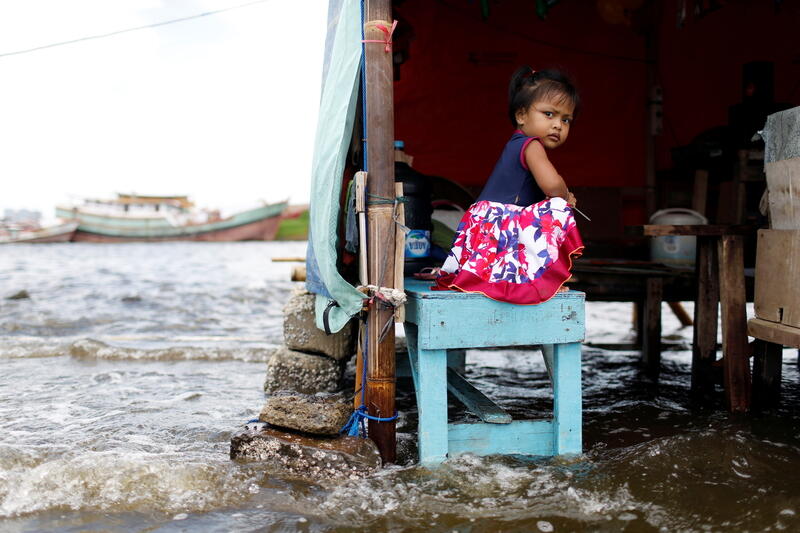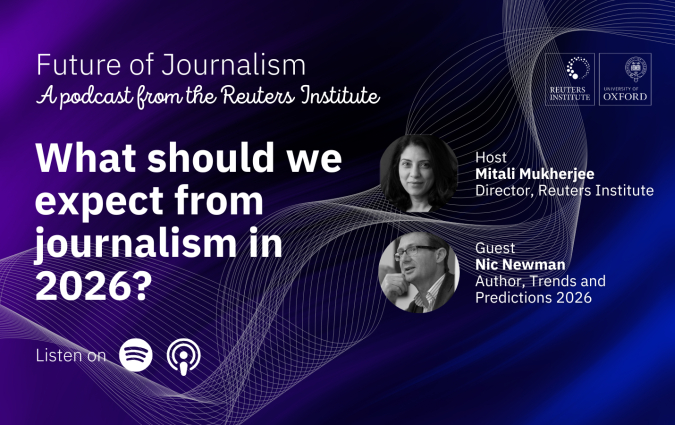What solutions journalism can bring to the news media in the Global South

Shaqueena Dwi Arsyilla, 2, sits on a bench at Kali Adem port, north of Jakarta, a place impacted by high tides due to the rising sea level. REUTERS/Willy Kurniawan
Research by the Reuters Institute suggests audiences may avoid the news because it negatively affects their mood or because they feel unable to take action. Solutions journalism, which takes an in-depth look at a response to a problem and at the effectiveness and limitations of this response, could directly address this root cause.
According to the Solutions Journalism Network (SJN), which trains journalists and tracks solutions stories around the world, this approach provides a more complete view of society, reveals “hidden opportunities”, strengthens citizenship and bolsters other forms of journalism.
Independent journalists in the Philippines and Indonesia, a hyperlocal news site in Costa Rica, and a journalism training initiative covering the Middle East and Africa are using this approach to share new, much-needed perspectives from these countries to challenge traditional narratives and provide ideas to tackle global issues.
Development journalism has long told the stories of communities in the Global South facing economic, social and environmental challenges. For these journalists and journalism organisations, a solutions journalism model offers a different way to tell these stories, shifting the focus from the problem to an evaluated solution in a way that can inspire communities and audiences to take real-world measures.
Showing people ways to take action against problems in their community is one the goals of people like Tina Rosenberg, co-founder of the SJN, and Mikhael Simmonds, who has worked with local journalists for years and who leads SJN’s work in Africa. “[It’s about] regaining a sense that a lot of problems can be solved or are solved locally,” Simmonds says.
Addressing global warming
People in the Global South, especially those in poorer communities, are often the most affected by global crises such as climate change, education inequality and food insecurity. These problems are often interlinked too. Understanding how communities are dealing with these problems is a rich source of stories for journalists in these regions and can offer critical insights to others.
Filipino journalist Portia Ladrido, co-founder of INKLINE and coordinator of the SJN’s Metro Manila hub, uses this approach to find new angles and bring the audience closer to the story. Reporting on how the country’s drug war is affecting women, her 2019 story for CNN Philippines on a sewing facility for women who had lost their livelihoods prompted inquiries from readers about how they could donate, buy products or commission work from these women.
“The approach gives readers agency and makes the whole community involved in the story. There’s a synergy between readers, journalists and community members wanting to work together,” says Ladrido.
Photojournalist Michael Eko, who works between Indonesia and the Philippines, says the rigorous approach of solutions journalism can help the communities on which he reports take direct action. His project as part of the Solutions Visual Journalism Initiative documents how indigenous people in the village of Punan Adiu, northern Indonesia, have obtained legal recognition to protect and manage the forest in which they live. As part of working with the Punan and other local peoples, he has shared how to use photography and cataloguing techniques to document plants, species and the medicinal properties of the forests. This evidence can help aid legal fights to register and protect their lands.
In the northwestern Costa Rican province of Guanacaste, non-profit, bilingual newspaper La Voz de Guanacaste aims to give voice to an area much neglected by mainstream media. Through solutions journalism they aim to further empower its audience by not just reporting a problem but showing them how they might change it.
“Solutions stories give a sense of hope that not all is lost,” says Gabriela Brenes, Director of La Voz. They can also create “a sense of pride and resilience” in a province which is “vibrant and complex” but often overlooked. “Whenever we publish these stories, it sparks a sense of ownership and resilience that translates into this pride saying, ‘We made it against all odds, and here's everything the province is doing,’” she says.
There’s a strong tradition of investigative reporting in Latin America, says SJN’s Rosenberg, but it’s often been focused on the national level. “Nabbing the president with his hand in the till is very important, but probably has less interest to the average reader than something about why a local hospital has no medicines and what can be done about that. Solutions journalism turns journalists towards those everyday problems their readers are facing in a way that traditional investigative reporting, as important as it is, does not.”
La Voz’s Brenes says that these stories have a wider appeal to the site’s multiple audiences and they often better bridge the cultural gap between its Spanish-speaking audiences and the tourists and expats than other types of news. Its solutions journalism approach began in September 2018 following a grant from the CRUSA Foundation. But by the time the grant ended, this had become part of the newsroom’s DNA.
This new approach has allowed La Voz’s nine-person strong newsroom to find new angles, in particular to long-running stories. “With stories that we report year after year, over and over, [solutions journalism] is a chance to change focus onto things or people that are working to mitigate these problems,” says Noelia Esquivel, the newsroom’s lead reporter for solution-driven stories.
A positive answer
Trying to shift how her region and others are perceived externally and internally was part of the motivation for former BBC journalist Dina Aboughazala to launch EGAB, a solutions journalism initiative started in August 2020 for local journalists in the Middle East and Africa.
EGAB’s name is derived from the Arabic word Egabiya, which means positivity, and Egaba, which means answer. The project offers training and coaching to journalists in these regions by helping them secure pitches with international news outlets.
Having worked inside and outside her home country of Egypt, Aboughazala says solutions journalism has been missing in the Middle East and Africa. “Egypt is always in the news for the worst reasons. People think that our countries only offer problems and there’s no chance anything will be fixed. This is the message they keep hearing from the media: wars, conflicts, poverty… [as if] all the good things are happening in the West,” she says.
Solutions stories can provide balance to that narrative while also evaluating the work of NGOs and their problem-solving, says Simmonds. The SJN’s initiatives in Africa work with local journalists and media outlets, as well as providing training to news organisations. The network has either regional or country-based partners to help it best understand the demand and needs of audiences and journalists in the area.
“In the local context, you get nuances about the availability of data and what language makes most sense,” Simmonds says. “We help them understand what robust solutions journalism looks like, but we want them to adapt it and run with it as they see fit. It has to make as much sense to the audience as possible and not be just what we think makes sense.”
This approach can show local populations that there are initiatives bringing positive change in the region, bridging the gap between perception and reality. Solutions then become “more realistic” to local people, countering the idea that “the only solution to problems is to leave this region for good and go to other regions where everything is perceived as fixed”, explains Aboughazala. In some nations, politicians use the idea of negative news coverage, especially from international outlets, to portray the media and journalists as dangerous, something that solutions journalism can help counter, she says.
Solutions to climate change
According to La Voz’s Brenes, solutions journalism works well for environmental stories too. Narratives about Guanacaste or Costa Rica often fall between two extremes: the story of a natural, eco-friendly paradise or the location of a natural crisis, such as a hurricane or a drought. “Solutions stories help us bring light to a lot of the nuances that are missed in between. Certain populations and ethnic groups often overlooked find a space to be part of the social conversation,” she says.
In The Philippines, climate change adaptation and mitigation efforts are happening at a local level. However, national media tends to disregard them despite the fact that the country is highly vulnerable to the impacts of climate change. Ladrido feels this topic is “very ripe” for solutions stories. This approach requires evidence of impact and climate change solutions are measurable and science-based.
The audiences of La Voz have an appetite from these kinds of stories. They are neighbours born and bred in Guanacaste, people raised in the province who have since moved to cities and expats living in the area. The news site measures engagement for solutions stories and see how these metrics compare to others, including by distribution channel, audience location, audience age and story theme. Pieces on solutions to environmental, and mental health problems or video reports on the pandemic response have performed better with younger audiences.
This reporting is also travelling beyond the borders of Guanacaste because of the solutions it presents. A new data-journalism project called Guanadata investigates public spending in six coastal communities in Costa Rica beyond its usual, hyperlocal focus on Guanacaste. The team found people in these outside communities were already reading solutions stories from Guanacaste because they offered approaches that could be replicated in their own areas.
A road to better standards
Aboughazala perceives EGAB as a possible fix to another regional problem: the low standard of journalism in some parts of Africa and the Middle East. She hopes to improve this over time through mentoring throughout the journalistic process, from pitch to story production and payment.
Opportunities for journalists in the region have declined due to low pay and the closure of international bureaux. Employment as a fixer may be possible, but this means no bylines and often low pay, says Aboughazala. By building new relationships between local journalists and trusted international outlets, she hopes EGAB can help solve this problem too.
To date, 100 journalists have shown an interest in using EGAB from countries including, Egypt, Iran, Sudan, Botswana and Yemen. Aboughazala’s plan is to expand further into Africa. But for EGAB to achieve this one of the biggest challenges is industry culture.
“There’s an appetite for solutions journalism but it’s not taken as seriously yet or institutionalised,” says Ladrido. This makes her more inclined to talk to younger journalists about the practice as a way of giving them a different approach to their work.
Solutions journalism is not hard to do but requires resources to be diverted from elsewhere, says SJN’s Rosenberg. These are the same barriers to doing good journalism in any region. But the problem is ten times as bad in Africa, Latin America and Eastern Europe. “These are shoestring operations for the most part”, she says, “so the question is how do you manage to do this when you don’t have the money for bus fare to go and report?”
Editors can be fixed in their ways of working or reliant on an established pool of freelancers from a region. Developing new voices and relationships can be considered too challenging and time-consuming. It’s a question of how committed newsrooms are to improving diversity, says Aboughazala, who actively seeks journalists working outside of urban areas. “If you are serious about diversity, we have this pool of really diverse journalists and stories. We will vet their ideas and commit to high standards of journalism to help editors and appeal to international audiences,” she says.
Any journalist interested in pursuing solutions journalism should learn how to do it well . The whole reporting process can take much longer, says Ladrido, as it covers the problem, the solutions and their limitations and impact.
The result is often not immediate, adds photojournalist Eko, and different groups in society may not agree: “A tribe in one village making a decision is easy. They are homogeneous. But what about heterogeneous communities who have different perspectives? There’s no collective decision and that’s a challenge to report. How they work together to solve the problem and learn from mistakes can be the most interesting part of the process,” he says.
These challenges aside, the advantages that solutions journalism can offer audiences and media outlets and journalists in the Global South are wide-ranging. The community Ladrido has helped build in the Philippines, including a nearly 200-person Facebook group, has made in-roads into other sectors, running sessions with lawyers, academics and climate change activists.
Lessons for other regions
There’s a growing interest in sharing ideas on solutions journalism between countries and regions in the Global South, Simmonds says: “Brazil has the same jungle transportation problems as Africa. So there are lessons about that which can be switched between both places.
There may be other opportunities. Communities in parts of the US dealing with flooding or poor internet connectivity could learn from solutions to these problems that have worked in parts of Africa. The same is true for the response to the pandemic: Africa has lots of experience tackling epidemics and others can draw lessons from it. “Solutions stories say, look at what these communities are contributing and what we can learn from them,” Simmonds says.
It’s not just knowledge that could be exchanged through solutions journalism. The hope and resilience that journalists in the Global South practising this approach mention could also transfer to other countries. The hope that solutions to global problems do exist and are available to us if we report and look beyond our own experience.
Laura Oliver is a freelance journalist based in the UK. She has written for the 'Guardian', BBC, 'The Week' and more. She is a visiting lecturer in online journalism at City, University of London, and works as an audience strategy consultant for newsrooms. You can find her work here.







